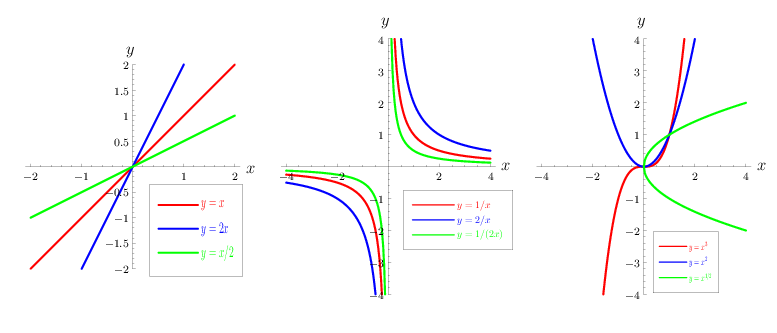Power function
A function  with
with
 |
where  is a constant number. If
is a constant number. If  is an integer, the power function is a particular case of a rational function. When
is an integer, the power function is a particular case of a rational function. When  and
and  have complex values, the power function is not single valued if
have complex values, the power function is not single valued if  is not an integer.
is not an integer.
For fixed real  and
and  , the number
, the number  is a power, and the properties of
is a power, and the properties of  therefore follow from the properties of the power.
therefore follow from the properties of the power.
When  , the power function
, the power function  is defined and positive for any real
is defined and positive for any real  . When
. When  , the power function
, the power function  is defined in the following cases.
is defined in the following cases.
a) When  , the power function
, the power function  is defined to equal 0 if
is defined to equal 0 if  , and is not defined if
, and is not defined if  . The power function
. The power function  is defined to equal 1 for all
is defined to equal 1 for all  ; in particular,
; in particular,  .
.
b) If  is a natural number, then the power function
is a natural number, then the power function  is defined for all
is defined for all  , and the power function
, and the power function  is defined for all
is defined for all  . Here
. Here  and
and  if
if  .
.
c) The power function  , where
, where  is an odd natural number, is defined for all real
is an odd natural number, is defined for all real  , and is negative when
, and is negative when  . However, it is sometimes convenient to restrict in this case the power function
. However, it is sometimes convenient to restrict in this case the power function  to
to  . The same statements apply for the power function
. The same statements apply for the power function  , when
, when  is an irreducible fraction. Here
is an irreducible fraction. Here  and
and  .
.

The properties of  are usually considered when
are usually considered when  and
and  is real, although many of them also hold when
is real, although many of them also hold when  and, for example,
and, for example,  is a natural number.
is a natural number.
Functions of the form  , where
, where  is a constant coefficient and
is a constant coefficient and  , express a direct proportionality (their graphs are straight lines passing through the origin of the coordinates (Fig.a)), while when
, express a direct proportionality (their graphs are straight lines passing through the origin of the coordinates (Fig.a)), while when  , they express an inverse proportionality (their graphs are equilateral hyperbolas with their centre at the origin of the coordinates and having the coordinate axes as their asymptotes (Fig.b)). Many laws of physics can be mathematically expressed by using functions of the form
, they express an inverse proportionality (their graphs are equilateral hyperbolas with their centre at the origin of the coordinates and having the coordinate axes as their asymptotes (Fig.b)). Many laws of physics can be mathematically expressed by using functions of the form  (Fig.c).
(Fig.c).
When  , the power function
, the power function  is continuous, monotone (increasing when
is continuous, monotone (increasing when  , decreasing when
, decreasing when  ), infinitely differentiable, and, in a neighbourhood of every positive
), infinitely differentiable, and, in a neighbourhood of every positive  , can be expanded into a Taylor series. Moreover,
, can be expanded into a Taylor series. Moreover,
 |
 |
 |
 |
when  , where
, where  are the binomial coefficients.
are the binomial coefficients.
In the complex domain, the power function  is defined for all
is defined for all  by the formula
by the formula
 | (*) |
where  . If
. If  is an integer, then
is an integer, then  is single valued:
is single valued:
 |
If  is rational (
is rational ( , where
, where  and
and  are relatively prime), then the power function
are relatively prime), then the power function  takes
takes  different values:
different values:
 |
where  are the
are the  -th roots of unity:
-th roots of unity:  and
and  . If
. If  is irrational, then
is irrational, then  has an infinite number of values: the factor
has an infinite number of values: the factor  takes different values for different
takes different values for different  . For non-real complex values of
. For non-real complex values of  , the power function
, the power function  is defined by the same formula (*).
is defined by the same formula (*).
Comments
Also regarding formula (*), the symbol  is an abbreviation for the value
is an abbreviation for the value  of the exponential function exp at the complex number
of the exponential function exp at the complex number  . This function is defined by the series
. This function is defined by the series
 |
which converges (absolutely) at each complex  . Note that
. Note that  if
if  .
.
Taking  and
and  in (*) one obtains the principal value. An interesting example is obtained if
in (*) one obtains the principal value. An interesting example is obtained if  :
:
 |
References
| [a1] | K.R. Stromberg, "Introduction to classical real analysis" , Wadsworth (1981) pp. 318ff |
| [a2] | K. Knopp, "Theorie und Anwendung der unendlichen Reihen" , Springer (1964) (English translation: Blackie, 1951 & Dover, reprint, 1990) |
| [a3] | J. Marsden, "Basic complex analysis" , Freeman (1973) |
Power function. Encyclopedia of Mathematics. URL: http://encyclopediaofmath.org/index.php?title=Power_function&oldid=11351